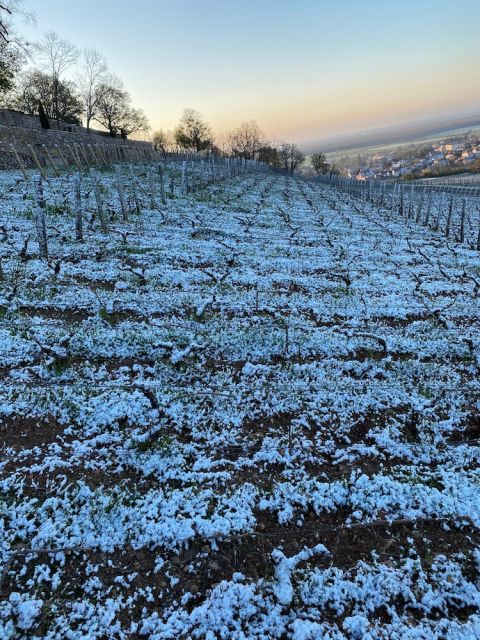2021 will certainly go down as a year to remember (or forget!) throughout many growing regions of Europe (see Europe's 2021 vintage shrunk by frost). However, spring temperatures in the Côte Chalonnaise are promising. We had a beautiful Easter week with plenty of sunshine and gorgeous blue skies, much-too-warm temperatures and mild nights that finally woke up Mother Nature. The first wild flowers began to blossom by mid-March, as well as our many almond and cherry trees in the Clos du Cellier aux Moines. Tulips and daffodils were also in full bloom by 1 April. It was a stunning sight!
In late March our Clos du Cellier Pinot Noir buds were gently bursting, as well as the Chardonnay buds in Puligny-Montrachet with even more in Montagny! Our winter plantings of Pinot Noir in the Clos du Cellier aux Moines were showing their first buds for Easter and on the Cellier’s south-facing terrace there was an explosion of peonies providing beautiful scenery during a noticeably quiet COVID-confined Easter with no family gatherings nor egg hunt for the grandkids…
The weather forecast became very scary the following week, with the advent of high frost risk announced for 7 and 8 April. Guillaume Marko, our technical director and co-manager, and his team sprayed a warming herb ‘tea cocktail’ on the vines in Givry, Puligny-Montrachet, Chassagne and Santenay. The tea cocktail is an infusion of oregano, thyme and savory, a warm-up message to the plant. The cocktail is also mixed with an extract of meadowsweet to stimulate the fluidity of the vines’ sap.
The drop in temperature became violent on 6 April, and with temperatures falling below zero on 7 April early in the morning for about five hours until sunrise – four to five degrees below zero with some icy snow covering the buds and the newborn leaves on the vines. Unfortunately, the same thing happened the next day. The impact was devastating for all vineyards in the Côte de Beaune and Côte Chalonnaise, and maybe slightly less in the Côte de Nuits, where the Pinot Noirs were less advanced than the Chardonnay buds. Candles and big fans did not seem to help as the cold wave lasted too long, was way too thick and too stagnant. Most of the buds and young leaves were killed and dried out in a few days – just a few survived. We started counting the few ‘survivors’, hoping for base-buds to take over but, alas, we did not know if we had already lost 100%, 80% or half of the 2021 vintage.
Enter early June. So what can we hope for now? The weather in May was, unfortunately, not very favourable at all! It was wet, very cloudy and quite cool. We certainly welcomed the rain after last year’s drought, but vines continued their struggle to develop after the frost and desperately needed more sun. The leaves were pale green, even slightly yellowish. Our traditional spring debudding was conducted very carefully, trying to keep the most fertile sprouts, securing the harvest, and also preparing the plant for next year’s pruning. This is the art of anticipation but, alas, with all too little left to be secured! The future grape clusters are scarce and smaller than usual. Some late-coming base-buds have produced ridiculously small bunches which may not be fully ripe at harvest time. We are most likely looking toward a harvest in mid to late September, depending on the warmth in late summer. However, the first week of June proved to be magnificent, and we were able to observe the first buds in Givry so that full flowering will begin on 12 June for the Pinots and on 15 June for the Chardonnays.
Fortunately, we at least now have a clearer vision as to what to expect and what could produce the 2021 vintage. Here are some hard facts and figures of note:
- Montagny has lost 80% of its potential crop.
- Mercurey, Les Margotons, from a colder and later climat, has not suffered from frost.
- Clos du Cellier aux Moines in Givry as well as Clos Pascal have lost at least 50%.
- Chassagne-Montrachet and Santenay premiers crus have lost two-thirds, and Puligny-Montrachet, Les Pucelles has lost 50%.
- Finally, our new Volnay, Premier Cru En Chevret (more information coming this fall!), which was a bit late in spring, seems less affected, but this is yet to be confirmed.
In the cellar, we have just finished the barrel-ageing of the 2019 vintage. The final parcellaire of Clos du Cellier aux Moines has been assembled and is resting before being bottled in July. Same for the Côte de Beaune premiers crus. These bottles will rest for another year in our underground cellar, which we have just expanded and is connected to our gravity-fed winery. We are so happy to release these very promising 2019 wines later, in 2022. The 2020s are all in barrel and will remain there for a good year or more, given their concentration and intensity.
Great wines need time. Years pass and no two are alike – this is the life of a vigneron.














